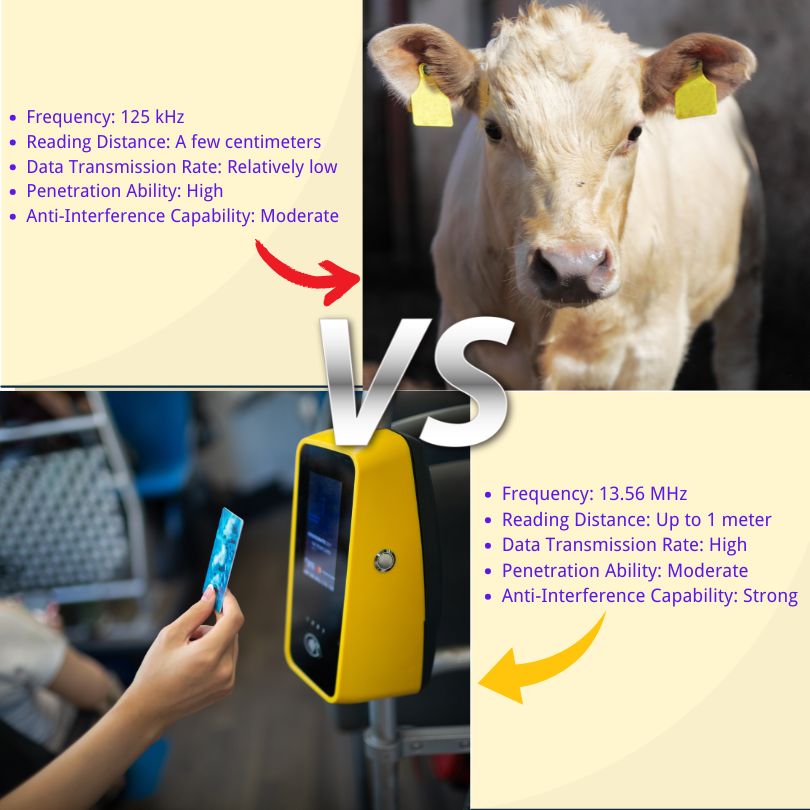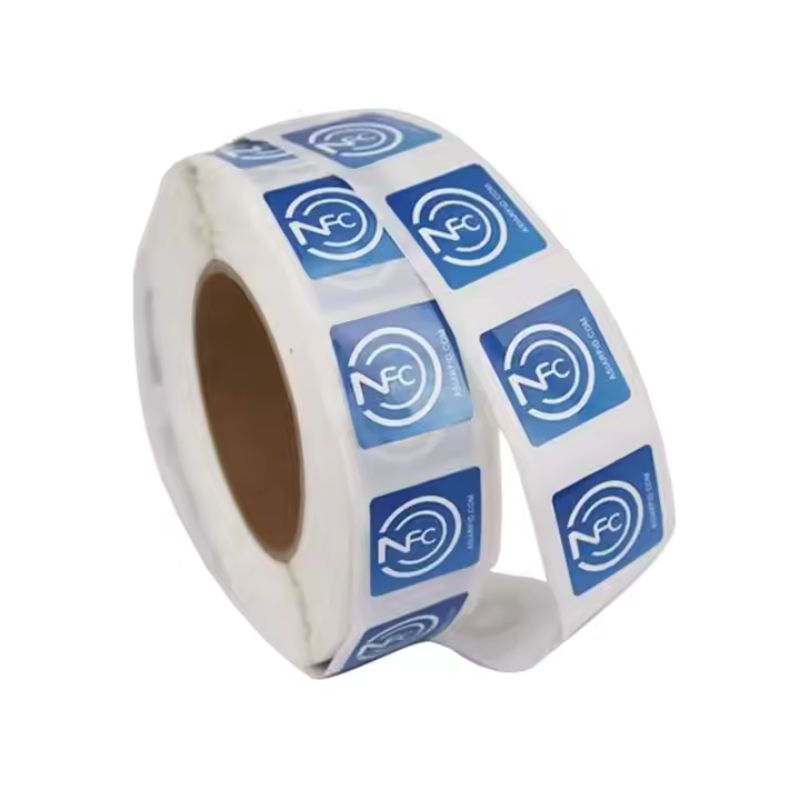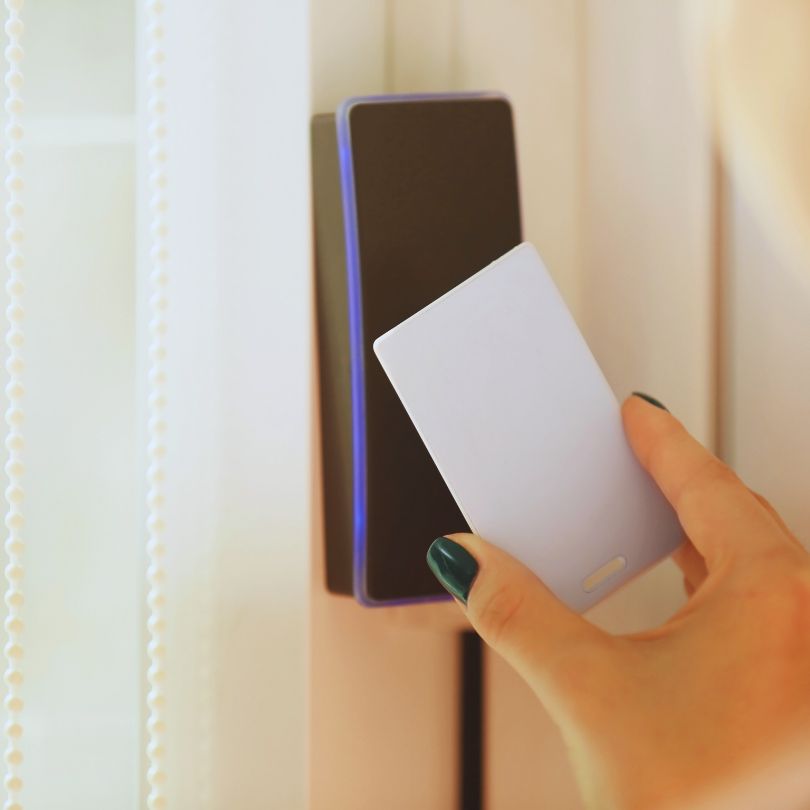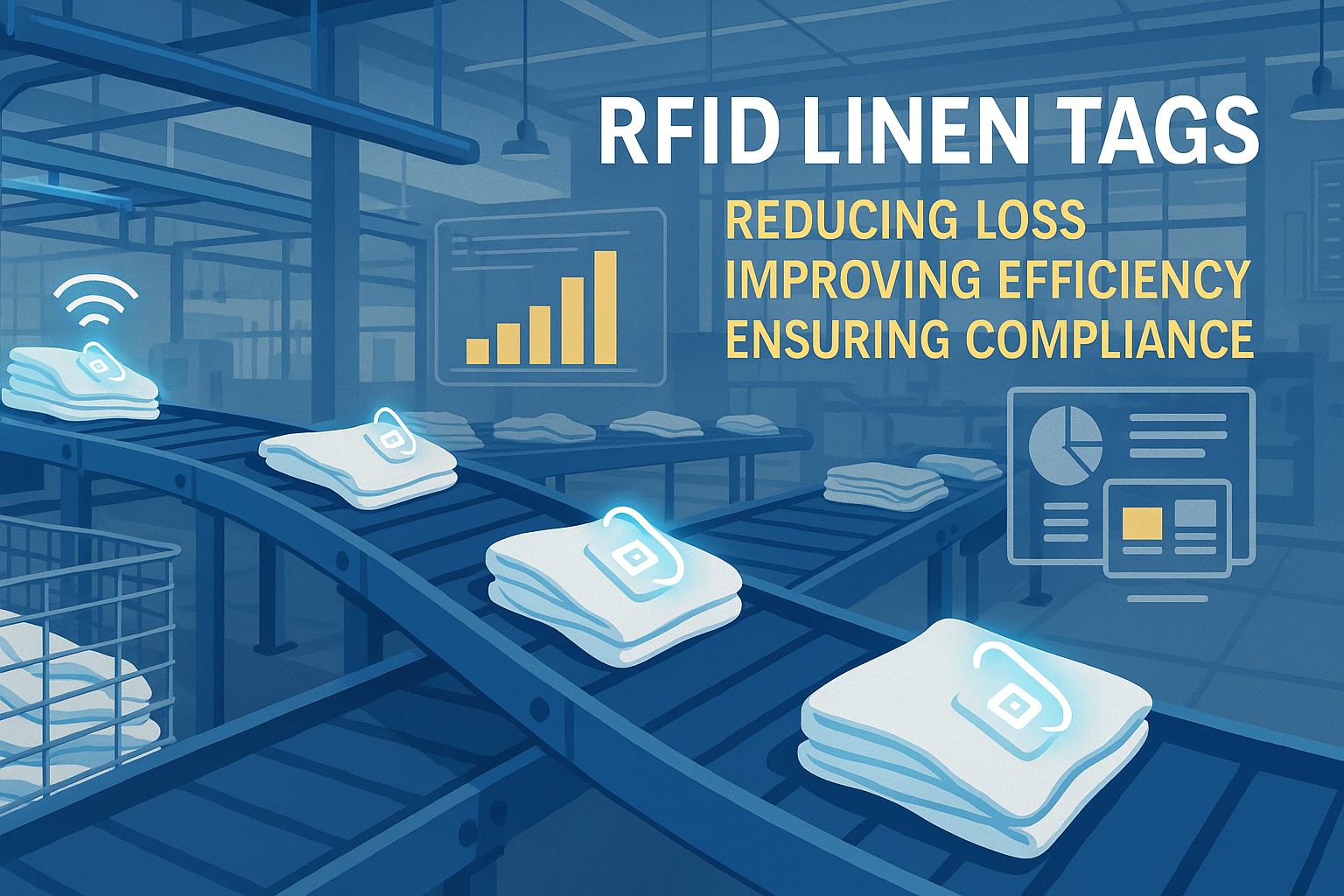
13,56 MHz ve 125 kHz RFID Etiketleri Arasındaki Farkları Anlamak
İçindekiler
13,56 MHz ve 125 kHz RFID Etiketleri Arasındaki Farkları Anlamak

RFID Frekansının Gerçek Anlamı (LF ve HF)
RFID sistemleri, iletişim için radyo dalgalarını kullanır. Etiketler ve okuyucular. Kullandıkları frekans, ne kadar uzağa okuyabileceklerini, verileri ne kadar hızlı gönderebileceklerini, metal veya su etrafında nasıl davranacaklarını ve ne tür verileri depolayabileceklerini etkiler.
İşte temel fikir:
Düşük Frekanslı (LF) = 125 kHz RFID Etiketleri
- Kısa menzil
- Daha yavaş veri hızı
- Metal veya sıvıların yakınında mükemmel performans
- Basit, sağlam ve uygun fiyatlı
Yüksek Frekans (HF) = 13.56 MHz RFID Etiketleri - Daha uzun menzil
- Daha hızlı veri hızı
- Daha gelişmiş güvenlik
- NFC ve akıllı telefonlarla uyumlu
13,56 MHz ile 125 kHz karşılaştırması
| Özellik | 13.56 MHz RFID Etiketleri | 125 kHz RFID Etiketleri |
|---|---|---|
| Sıklık | 13,56 MHz (HF) | 125 kHz (LF) |
| Okuma Aralığı | 1 metreye kadar | 2-10 cm |
| Veri Aktarım Hızı | Yüksek | Düşük |
| Metal Yakınında Performans | Ilıman | Güçlü |
| Güvenlik | Şifrelemeyi ve karşılıklı kimlik doğrulamayı destekler | Temel, genellikle şifreleme yok |
| NFC / Akıllı Telefon Desteği | Evet | HAYIR |
| Maliyet | Daha yüksek | Daha düşük |

Güvenlik: Tek Frekans Daha Güvenli mi?
125 kHz RFID Etiketleri genellikle eski sistemlerde kullanılır ve genellikle şifreleme içermeyen sabit benzersiz kimlikler kullanır. Bu da onları hazır cihazlarla kolayca kopyalanabilir hale getirir. Düşük riskli sistemler için uygundurlar, ancak modern güvenlik standartlarını karşılamazlar.
13,56 MHz RFID Etiketleri, özellikle MIFARE veya DESFire kartları, şunları destekler:
- Şifreleme
- Karşılıklı kimlik doğrulama
- Güvenli bellek depolama
- Tek bir kartta birden fazla uygulama
Sonuç olarak: - Düşük güvenlik gereksinimleri için (kilitli dolap anahtarları, zaman saatleri gibi) 125 kHz RFID Etiketlerini kullanmaya devam edin.
- Erişim kontrolü, ödemeler veya kişisel verileri depolayan herhangi bir sistem için 13,56 MHz'i seçin.
NFC ve Akıllı Telefon Uyumluluğu
Projeniz telefonları içeriyorsa, 125 kHz RFID Etiketleri çalışmayacaktır.
Sadece 13.56 MHz RFID Etiketleri NFC (Yakın Alan İletişimi) desteği — mobil ödemeler, check-in ve dokunarak eşleştirme özelliklerinde kullanılan teknoloji.
Çoğu akıllı telefon, 13,56 MHz frekansını kullanarak NFC etiketlerini okuyabilir ve yazabilir, bu da bu frekansı aşağıdakiler için ideal hale getirir:
- Dijital biletler
- Etkinlik check-in'leri
- Akıllı posterler
- Sadakat kartları
- Temassız mobil kimlik
Akıllı telefon desteği önemliyse, 13,56 MHz tek seçeneğinizdir.
Sektörlere Göre Gerçek Hayattan Kullanım Örnekleri
| Endüstri / Uygulama | 125 kHz RFID Etiketleri | 13.56 MHz RFID Etiketleri |
|---|---|---|
| Erişim Kontrolü | Temel giriş sistemleri, eski kapılar | Güvenli kimlik bilgileri, modern kimlik kartları |
| Toplu Taşıma / Biletleme | Desteklenmiyor | MIFARE/NFC tabanlı ücret kartları |
| Hayvan Takibi | Doku penetrasyonu nedeniyle yaygın olarak kullanılır | Nadir |
| Endüstriyel Otomasyon | Metal/sıvı yakınında güvenilir, sağlam kullanım | Zorlu ortamlarda daha az yaygın |
| Sağlık hizmeti | Hasta veya ilaç takibi için ideal değildir | Güvenli kimlik ve varlık etiketleme için daha iyi |
| Kütüphaneler / Arşivler | Nadir | Kitap takibi ve ödünç verme işlemleri için popüler |
| Pazarlama / Etkinlikler | Uygulanamaz | Akıllı posterler, NFC etkinlik kartları |
| Araç Hırsızlığı Önleme | Anahtarlar/kontak anahtarlarına gömülü 125 kHz RFID etiketleri | Kullanılmıyor |

Projeniz için 13,56 MHz ve 125 kHz arasında nasıl seçim yapabilirsiniz?
Kararınızı daraltmak için bu kontrol listesini kullanın:
1. Güvenlik Seviyesi
- Şifreleme veya güvenli erişim mi ihtiyacınız var? → 13,56 MHz'yi tercih edin
- Düşük riskli izleme veya temel kimlik? → 125 kHz yeterli olabilir.
2. Çevre
- Yakınlarda yüksek parazit, metal veya sıvı var mı? → 125 kHz daha iyi sonuç verir
- Temiz ofis mi, kapalı alan mı? → Her ikisi de uygundur; özelliklere göre seçim yapın.
3. Akıllı Telefon Entegrasyonu
- Kullanıcıların telefonlarıyla tarama yapmasını mı istiyorsunuz? → Yalnızca 13,56 MHz bunu destekler.
4. Bütçe
- 125 kHz etiketler ilk etapta daha ucuzdur
- Ancak, özelliklere veya güvenliğe ihtiyacınız varsa, 13,56 MHz daha uzun vadeli bir değer sunar.
Hala 125 kHz RFID Etiketleri mi Kullanıyorsunuz? Yükseltme mi, Kalma mı?
125 kHz RFID Etiketleri hala aşağıdaki alanlarda yaygın olarak kullanılmaktadır:
- Eski erişim kontrol sistemleri
- Fabrika zemin operasyonları
- Hayvan etiketleme
- Otomatik hırsızlık önleme sistemleri
Ancak yönetiyorsanız: - Personel kimlik bilgileri
- Ödeme sistemleri
- Çok amaçlı kimlik kartları
- NFC entegrasyonu
…o zaman değiştirme zamanı gelmiş olabilir.
Yükseltme Yolları:
- Çift frekanslı okuyucular kurun
- Kombinasyon kartları yayınlayın (hem 13,56 MHz hem de 125 kHz'yi destekler)
- Kademeli geçiş: geçiş sırasında her iki sistemi de destekleyin
13,56 MHz ve 125 kHz RFID Hakkında Sıkça Sorulan Sorular
13,56 MHz, NFC ile aynı mıdır?
Evet, NFC 13,56 MHz RFID türüdür. Çoğu akıllı telefon bunu destekler.
Bir okuyucu her iki frekansı da okuyabilir mi?
Genellikle hayır. Her ikisini de kullanmak için çift teknolojili bir okuyucuya ihtiyacınız olacaktır.
Hangi etiket daha uzun menzile sahiptir?
13,56 MHz genellikle daha uzun okuma menziline sahiptir (1 metreye kadar). 125 kHz ise birkaç santimetre ile sınırlıdır.
Erişim kontrolü için hangisini kullanmalıyım?
Modern, güvenli erişim sistemleri için 13,56 MHz şiddetle tavsiye edilir.
13.56 MHz ve 125 kHz RFID etiketlerinin okuma mesafeleri neden farklıdır?
Okuma mesafelerindeki fark, öncelikle çalışma frekansından kaynaklanır. 13,56 MHz gibi daha yüksek frekanslar daha geniş bir aralığa sahipken, 125 kHz gibi daha düşük frekanslar daha kısa mesafeler için optimize edilmiştir.
Hangi RFID etiketi metal veya sıvı ortamlar için daha uygundur?
125 kHz RFID etiketleri üstün penetrasyon kabiliyetleri nedeniyle metal veya sıvıların bulunduğu ortamlarda daha etkilidir.
RFID etiketlerinin maliyeti seçimi etkiliyor mu?
Evet, 125 kHz RFID etiketleri genellikle daha uygun maliyetlidir ve bu da onları bütçeye duyarlı uygulamalar için uygun bir seçenek haline getirir. Ancak, seçim performans gerekliliklerini ve uygulama ortamlarını da dikkate almalıdır.
Anahtar Standartlar ve Çip Türleri
13,56 MHz (HF)
- ISO/IEC 14443: Temassız kartlarda kullanılır (MIFARE, DESFire)
- ISO/IEC 15693: Daha uzun menzil, kütüphanelerde ve lojistikte kullanılır.
- ISO 18000-3: Ürün düzeyinde takip
125 kHz (LF)
- Özel formatlar, genellikle sabit kimlikli (ör. EM4100, HID Prox)
- Çoğunlukla eski sistemlerde ve temel uygulamalarda kullanılır.
Sonuçlar
Hala hangi yolu seçeceğinizi merak ediyorsanız, işte özet:
125 kHz RFID Etiketlerini şunlar için kullanın:
- Zorlu koşullar (metal/sıvı)
- Düşük güvenlikli uygulamalar
- Bütçeye duyarlı dağıtımlar
- Eski sistemler
13,56 MHz RFID Etiketlerini şu amaçlarla kullanın:
- Mobil/NFC desteği
- Güvenli erişim ve ödeme
- Çok amaçlı kartlar
- Geleceğe hazır sistemler
Her ikisinin de yeri vardır, ancak sadece maliyet veya alışkanlık değil, kullanım durumuna göre seçim yapmalısınız.
Yorumlar
Sıcak Ürünler

RFID Atık Yönetimi Nedir?
Her çöp kutusu konuşan bir şehir hayal edin — kelimenin tam anlamıyla değil — ama küçük bir çip aracılığıyla sisteme ne zaman dolduğunu, ne zaman boşaltıldığını ve nereye gittiğini bildiren bir şehir. RFID atık yönetimi bugün bunu yapıyor.

Cıvata Contaları ve Uygulamaları Nelerdir? | Eksiksiz Kılavuz
Küresel ticaret ve lojistikte, sürgülü mühürler kargo güvenliği ve uyumluluğunun sağlanmasında çok önemli bir rol oynar. Bu küçük ama güçlü cihazlar, nakliye konteynerlerini, römorkları ve kargo kapılarını kurcalanmayı önleyen bir mekanizma ile kilitlemek için tasarlanmıştır.

RFID Kart Koruyucu Nedir? Faydaları, Kullanım Alanları ve Satın Alma Rehberi
RFID teknolojisi (Radyo Frekansı ile Tanımlama) her yerde: kredi kartlarınızda, kimlik kartlarınızda, transit geçiş kartlarınızda, otel odası anahtarlarınızda ve daha fazlasında. Hız ve kolaylık sunuyor, ancak aynı zamanda "skimming" adı verilen yeni bir dijital hırsızlık türüne de kapı açıyor. İşte bu noktada RFID kart koruyucular devreye giriyor.

Etkinlikler için RFID Bileklikler: Organizatörler için Toplu Satın Alma Rehberi
Etkinlikler için RFID bileklikler, konserlerde, festivallerde ve spor salonlarında daha hızlı giriş, sahtekarlığı önleme ve nakitsiz ödemeye ihtiyaç duyan organizatörler için tercih edilen çözüm haline geliyor. Kağıt biletlerin veya QR kodlarının aksine, bu akıllı bileklikler erişimi kolaylaştırmak, işlemleri güvence altına almak ve konuk deneyimini iyileştirmek için gömülü çipler kullanır.

Ön Camdaki RFID Etiketi Araç Erişim Kontrolü ve Ücretli Geçiş Sistemlerini Nasıl İyileştiriyor?
Günümüzün hızlı dünyasında araç tanımlamanın hızlı, güvenli ve temassız olması gerekir. Ön Camdaki bir RFID Etiketi tam olarak bunu sağlar - araçları durdurmadan geçiş ücreti toplama, park etme ve kapılı erişimi yönetmenin güvenilir bir yolu.

Ticari Çamaşırhanelerde RFID Keten Etiketlerinin Faydaları
Hastanelerde, otellerde veya büyük çamaşırhane hizmetlerinde çamaşırhaneyi yönetmek büyük bir iştir. Her gün binlerce çarşaf, havlu ve üniforma yıkanır, tasnif edilir ve geri gönderilir. Ancak kayıp çarşaflar, tasnif hataları ve manuel sayım gibi sorunlar şirketlere çok pahalıya mal olabilir. Örneğin, orta ölçekli oteller kayıp çarşaflar nedeniyle her yıl $200.000'den fazla para kaybedebilir.
İşte RFID Keten Etiketleri burada devreye giriyor.
Etiketler
İLGİLİ BLOG'LAR

RFID Atık Yönetimi Nedir?
Her çöp kutusu konuşan bir şehir hayal edin — kelimenin tam anlamıyla değil — ama küçük bir çip aracılığıyla sisteme ne zaman dolduğunu, ne zaman boşaltıldığını ve nereye gittiğini bildiren bir şehir. RFID atık yönetimi bugün bunu yapıyor.

Cıvata Contaları ve Uygulamaları Nelerdir? | Eksiksiz Kılavuz
Küresel ticaret ve lojistikte, sürgülü mühürler kargo güvenliği ve uyumluluğunun sağlanmasında çok önemli bir rol oynar. Bu küçük ama güçlü cihazlar, nakliye konteynerlerini, römorkları ve kargo kapılarını kurcalanmayı önleyen bir mekanizma ile kilitlemek için tasarlanmıştır.

RFID Kart Koruyucu Nedir? Faydaları, Kullanım Alanları ve Satın Alma Rehberi
RFID teknolojisi (Radyo Frekansı ile Tanımlama) her yerde: kredi kartlarınızda, kimlik kartlarınızda, transit geçiş kartlarınızda, otel odası anahtarlarınızda ve daha fazlasında. Hız ve kolaylık sunuyor, ancak aynı zamanda "skimming" adı verilen yeni bir dijital hırsızlık türüne de kapı açıyor. İşte bu noktada RFID kart koruyucular devreye giriyor.




